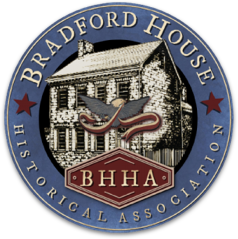A National Historic Landmark — Est. 1788
Step back in time at the Bradford House.
Experience its beauty and heritage as guides in period clothing present its history, authentic furnishings, educational exhibits, and 18th-century garden, complete with a well house and log kitchen cabin.
Politics

Built in 1788 by David Bradford, a prominent lawyer and a leader of the 1794 Whiskey Rebellion, this National Historic Landmark was restored and opened as a museum in 1965.
A visit to the Bradford House Museum is an immersion into the political excitement of the first citizen challenge to the newly forged United States Constitution. Meet the men and women who experienced the 1790s southwestern Pennsylvania frontier's brutality and glory as they struggled to build a civilized society. Experience architecture, artifacts, art, and illuminating text along the way. Take away a living history lesson in justice, equality, and equity.
The House
The museum is an exhibit of 18th-century living, representing both the lifestyle of the wealthy and of the ordinary citizen. The original stone house portrays the relative comforts and luxuries enjoyed by David and Elizabeth Bradford. Its period antiques, interesting artifacts, and authentic reproductions are elucidated during the immersive tour experience provided by costumed interpreters. Each room has replica items that may be handled by guests, such as the coins in the parlor, the cup and ball toy in the children’s room, and the fiber and textile samples in the workroom.
Exhibits
The upstairs room of the circa 1805 addition to the original house is used as a dedicated exhibit room. Exhibits include historical photos of the Old Stone House, as this structure was called. You’ll see display cases of antique hand tools, artifacts found on the property, and stones from the original National Road, handmade dolls representing historic personages in accurate detail, and framed historic maps.
The long table and chairs in the center of the room may be used by researchers who access our small reference library or for hands-on activities, such as building a cabin from toy logs or decorating a Christmas ornament.
The Bradfords
Panels on one wall feature the Bradfords, with a family tree and information about David, Elizabeth, and their children, illustrated with images of primary source documents. Several of these documents relate to David Bradford as an enslaver and an abolitionist, to address a question frequently asked by visitors.
Rebecca Harding Davis
Another panel exhibit is dedicated to the second famous person associated with the house, Rebecca Harding Davis, 19th century author and journalist, who was born here in 1831 and later owned the house.
Annual Exhibits
Another board is used for an annual exhibit, such as Tools & Trades and Farm & Home, tying into the theme for our summer children’s day camp but intended for education of visitors of all ages.
The Log Cabin
The museum includes a reconstructed log cabin kitchen which showcases the type of home most frontier families inhabited; hearth cooking demonstrations are possible in the working fireplace. The garden, in season, showcases flowers and herbs that were used for culinary, medicinal, and other purposes, and has a sundial that fascinates visitors. The wellhouse emphasizes the physical labor that was part of an ordinary day in the 1790s.

The Gardens and Murals
Throughout the spring, summer and fall, the Bradford House Garden is vibrant with ornamental flowers and beneficial herbs, laid out in 18th-century fashion with a sundial in the center.











